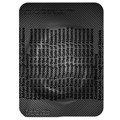Adrian Kiss − Through the Gate of Absence
Futura - Center for Contemporary Art, Holečkova 49, Prague 5 - Smíchov
December 5, 2017 - February 18, 2018
|
Adrian Kiss − Through the Gate of AbsenceFutura - Center for Contemporary Art, Holečkova 49, Prague 5 - SmíchovDecember 5, 2017 - February 18, 2018
curator: Michal Novotný
Coherent sculptural installation prepared specifically for FUTURA gallery develops on author’s interest in emotive formal vocabulary. Kiss builds structures based on formal elements abstracted from modern product design, that associates technology as dynamic, powerful, masculine, with elements that could be stereotypically perceived as rural, fragile or feminine. In the exhibition entry stands a gate, inspired by traditional, largely decorated wooden gates from historical Szekely region, today’s Romania. Three pillar division with main double door entry and smaller pedestrian gate resembles modern asymmetric composition. That is however further abstracted and modified, some parts and motives kept, others erased. The typical crossing of verticals, diagonals and rounded shapes finally constructs a certain spatial pictogram, that is both contemporary and historic, and similarly to other Kiss’s works operates on a level of abstracted universality. The composed bouquet, assembled from both exotic and central European flowers and woody plants further interrupts the raw coldness of this steel structure emotionally, in a nostalgic spirit, associating certain memory, but also memorial, and simultaneously in its decorativeness, embellishment, generous uselessness, standing in strong contrast to the hard introversion and demarcational posture of the gate. In their alliance those two extremely symbolically loaded motifs consequently gain even a more mythological character. Textile sculptures arbitrarily hanged over outstretched wires in a manner close to drying laundry, wear the motif of two Manga faces. Although almost entirely unrecognizable due to the size and folding, remaining only as dynamically crossing lines of the character’s hair, that due to the stitching and multiple spray paint layers, bend the shape of the fabric, as somehow a materialisation of the content into a final form. Here continues Kiss’s constant self-reflexive contradicting: the nature of an object with its perfection aspiring fabrication, resembling up to date expensive fashion commodities, finally twists with the eroded hardened surface and way of adjustment into a musty-like blanket or a hanging rag. This constant conflict of polarities pushed from one to another extreme, unfolds also in the series of aerodynamical shapes, abstract designs, once more perfectly composed, almost immaterial, and in their metal incarnation reminding cutting-stabbing weapons from a futuristic comics. The aggressive, active potential is here however once more neutralised with the wrapped up winter jacket, somehow a padding or a bandage, under which all the detailed precise shape collapses. But also this jacket is finally a sleek, clean and definitely arranged product. Second gate, unfolding into juxtaposed verticals and diagonals, operates in contrast and associative consequence with expressively scratched car bonnet. There is definitely a contrapost in how the perfectly shaped and shiny polished car bodies, as symbols of ideal purity and flawlessness of design, and visual product marketing, in one traumatic moment, necessitating from the reality of metropolitan traffic situation, scratches, breaks and perforates. Kiss however from his very own logic stretches this mechanical cancellation of the object essence, to yet another level of expressively lyrical painting on the car bonnet realised in fiery colours. Kiss work is a constant spiral of self reflexion leading to consequent self contradictions, cancellations of one owns identities escalated to the end and backwards. This nonetheless reminds us about the universal impossibility of neutral stance in our own perception, today even so burdened by the sediments of marketing communication, constantly arousing new and new emotions. But also the impossibility of reaching the authentic, original identity of our own selves, in whose active creation we always necessarily fall into these or other stereotypical patterns, despite or maybe precisely because we are part of culture rooted in the idea of constant innovation. Michal Novotný
|


